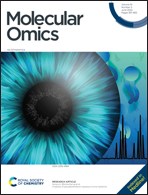Metabolomics assessment of vitamin D impact in Pam3CSK4 stimulation†
Abstract
Bacteria are amongst the leading causes of mortality worldwide. Although several studies have proposed the possible therapeutic role of vitamin D in bacterial infection, the exact mechanism through which vitamin D functions in antibacterial immunity remains elusive. The metabolic reconfigurations induced by vitamin D in bacterial infection can therefore be explored through metabolomics, a multidisciplinary ‘omics’ science that evaluates the metabolic changes of a biological system by identifying and quantifying metabolites under specific conditions. In the present study, cultured U937 macrophages were treated with Pam3CSK4/mL, 1,25(OH)2D3 and a combination of Pam3CSK4/mL and 1,25(OH)2D3. These treatment/stimulated U937 cells were compared to untreated cells in order to measure the metabolic effect of vitamin D (1,25(OH)2D3). Intracellular metabolomics was performed using nuclear magnetic resonance. The obtained data were subjected to chemometric modelling and statistical analyses, which revealed a clear distinction between the metabolic profiles of Pam3CSK4 stimulated cells, 1.25(OH)2D3 supplemented cells and cells supplemented with a combination of Pam3CSK4/1.25(OH)2D3 as compared to the untreated cells. Significant differences (p < 0.05) were identified in 32 metabolites linked to bioenergy production, redox reaction regulation, inflammation and protein synthesis. The generated results illustrate that 1.25(OH)2D3 reprogrammes the metabolic profile of U937 cells stimulated with Pam3CSK4.



 Please wait while we load your content...
Please wait while we load your content...